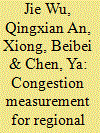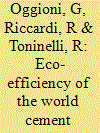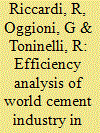|
|
|
Sort Order |
|
|
|
Items / Page
|
|
|
|
|
|
|
| Srl | Item |
| 1 |
ID:
121333


|
|
|
|
|
| Publication |
2013.
|
| Summary/Abstract |
The industry in China has been developing extensively in the last few decades. Large investments in China's industry may cause congestion because congestion is a widely observed economic phenomenon in such a scenario. In order to know the performance and allocate resources well, it is necessary for the Chinese government to measure congestion of the industry. Many scholars have studied this topic by means of data envelopment analysis (DEA). However, previous studies only pay attention to the framework of desirable outputs. In fact, undesirable outputs often accompany desirable outputs in production. Thus, in this study, a new approach for measuring congestion with undesirable outputs is proposed and applied to analyzing congestion of the industry in 31 administrative regions of China. The results show that five regions have congestion in their industry in 2010. Besides, the regions located in the east of the country perform the best in ecological efficiency, followed by regions in central and west China. Based on these findings, this paper proposes some political schemes to improve regional industrial efficiency.
|
|
|
|
|
|
|
|
|
|
|
|
|
|
|
|
| 2 |
ID:
098681


|
|
|
|
|
| Publication |
2010.
|
| Summary/Abstract |
Energy use in the production of desirable output often results in the generation of undesirable emission with detrimental impact on the environment, and whose disposal is frequently monitored by public authorities. Previous studies, however, paid little attention to undesirable output and environmental regulation related to its disposal while estimating energy use efficiency. Analysis of energy efficiency ignoring undesirable output could result in biased estimates of efficiency. Thus the aim of this paper is to estimate energy use efficiency in the presence of energy related undesirable emission by taking Indian cement industry as a suitable context of my analysis. Depending on the presence and absence of undesirable output and environmental regulation, three measures of efficiency have been estimated at the state level from 2000-01 to 2004-05 by applying Data Envelopment Analysis. Energy efficiency is defined as the ability of the producer to reduce the energy input to the largest extent possible, conditional on the given level of output and non-energy inputs. Empirical results reveal that energy efficiency estimates are biased if only desirable output is considered. Results also demonstrate that environmental regulation has a reinforcing effect on energy use efficiency.
|
|
|
|
|
|
|
|
|
|
|
|
|
|
|
|
| 3 |
ID:
104965


|
|
|
|
|
| Publication |
2011.
|
| Summary/Abstract |
Chemical reactions and the combustion of dirty fuels, such as coal and petroleum coke (petcoke), that are used in cement production processes generate a significant amount of CO2 emissions. In this paper, we provide an eco-efficiency measure for 21 prototypes of cement industries operating in many countries by applying both a data envelopment analysis (DEA) and a directional distance function approach, which are particularly suitable for models where several production inputs and desirable and undesirable outputs are taken into account. To understand whether this eco-efficiency is due to a rational utilization of inputs or to a real carbon dioxide reduction as a consequence of environmental regulation, we analyze the cases where CO2 emissions can either be considered as an input or as an undesirable output. Empirical results show that countries where cement industries invest in technologically advanced kilns and adopt alternative fuels and raw materials in their production processes are eco-efficient. This gives a comparative advantage to emerging countries, such as India and China, which are incentivized to modernize their production processes.
|
|
|
|
|
|
|
|
|
|
|
|
|
|
|
|
| 4 |
ID:
112297


|
|
|
|
|
| Publication |
2012.
|
| Summary/Abstract |
CO2 emissions reduction and energy efficiency improvement are the targets of many environmental policies that aim at tackling climate change. The European Emission Trading is the best example of this engagement against climate change. Considering this framework, this paper studies the efficiency of the high energetic and CO2 emissions intensive cement production process in 21 world countries. Alternative formulations of standard data envelopment analysis models and a directional distance function approach are compared in order to detect the efficiency of the cement sector both in presence and in absence of carbon emissions. We first analyze the entire cement production process and we then concentrate on the production of clinker, a by-product of cement, that is the main responsible of CO2 emissions. Our results show that the inclusion or the exclusion of undesirable factors (CO2) influence efficiency levels as well as the investments in new technologies and the utilization of alternative fuels and raw materials in the cement and clinker production processes.
|
|
|
|
|
|
|
|
|
|
|
|
|
|
|
|
| 5 |
ID:
121341


|
|
|
|
|
| Publication |
2013.
|
| Summary/Abstract |
In order to assess the environmental efficiency of power industry in China, this paper first proposes a new non-radial DEA approach by integrating the entropy weight and the SBM model. This will improve the assessment reliability and reasonableness. Using the model, this study then evaluates the environmental efficiency of the Chinese power industry at the provincial level during 2005-2010. The results show a marked difference in environmental efficiency of the power industry among Chinese provinces. Although the annual, average, environmental efficiency level fluctuates, there is an increasing trend. The Tobit regression analysis reveals the innovation ability of enterprises, the proportion of electricity generated by coal-fired plants and the generation capacity have a significantly positive effect on environmental efficiency. However the waste fees levied on waste discharge and investment in industrial pollutant treatment are negatively associated with environmental efficiency.
|
|
|
|
|
|
|
|
|
|
|
|
|
|
|
|
| 6 |
ID:
143405


|
|
|
|
|
| Summary/Abstract |
Since the end of the 20th century, numerous studies have analyzed Chinese economic development to gauge whether China's rapid growth is sustainable. Most of these studies focused on assessing total factor productivity (TFP) in Chinese mainland provinces but suffered from methodological weaknesses by assuming constant returns to scale (CRS) for the production frontier and/or incorrectly modeling variables returns to scale (VRS) technology taking into account bad output such as carbon dioxide emissions. Our paper offers a right non-parametric programming framework based on weak disposability and VRS assumptions to estimate environmental growth convergence among Chinese regions characterized by size heterogeneity. We explicitly separate regional efficiency gaps into two components: The first studies the technical catching-up process on each one (technical effect), and the second reveals convergence or divergence in the combinations of input and output among regions (structural effect). Moreover, carbon shadow price levels for provinces can be derived through the dual version of our activity analysis framework. Our empirical work focuses on 30 Chinese regions from 1997 to 2010. The results emphasize that environmental growth convergence among regions has mainly relied on the structural effect. We find that the structural effect largely depends on the pollution cost convergence and not on the evolution of the relative prices of capital or labor. The carbon shadow price is increasing at an annual rate of 2.5% and was evaluated around 864 yuan per ton in 2010 in China while regional estimates show significant disparities at the beginning of the period.
|
|
|
|
|
|
|
|
|
|
|
|
|
|
|
|
| 7 |
ID:
176814


|
|
|
|
|
| Summary/Abstract |
Environmental and technical efficiency in the electricity sector is a major focus of regulatory policies aimed at hastening greenhouse gas reduction and lowering energy prices for final consumers. Understanding the impact of market and environmental regulations on efficiency is crucial for the design and choice of policy packages. At the national level, the productivity response to regulations depends on unobserved country-specific factors that current empirical analyses have not modelled. In this framework, we analyse the regulation effects on efficiency in the electricity sector for a panel of European Union countries. We explicitly consider the effects of the environmental regulation along with the market regulation. Our estimation strategy uses the Bayesian shrinkage estimator, which can deal with the bias aggregation problem and cross-country heterogeneity. It allows us to identify the different transmission channels through which regulatory policy is implemented. The results highlight divergent behaviours at the country level. The direct impacts of the market and environmental regulatory policies on productivity are negative—around −2.7% and −2.3%, respectively—but the countries vary in the degree to which they are able to compensate these negative effects.
|
|
|
|
|
|
|
|
|
|
|
|
|
|
|
|
|
|
|
|
|